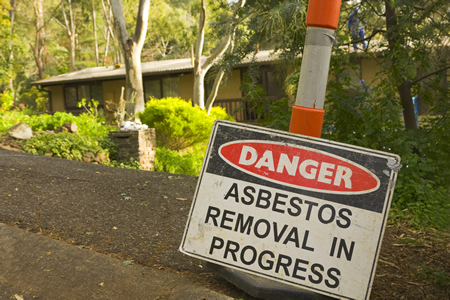
What is Asbestos
Because of its strength and chemical and thermal resistance, asbestos had been widely used in many building materials in the past. Asbestos is a carcinogen and can cause lung cancer and mesothelioma, making it extremely hazardous work with. If handled improperly, it can release small particles into the air, making it extremely hazardous to anyone coming in contact with it.
Asbestos removal is NOT a DIY project! Due to the hazardous consequences of asbestos exposure, strict regulation and procedures have been put in place to prevent asbestos exposure. If you are unsure about any building materials in your home or commercial building, please call a professional asbestos removal and abatement contractor before disturbing it.
Asbestos Removal Basics
If you suspect asbestos building materials in your home or building, the first step is to have it tested to make sure it contains asbestos. The second step would be to have it professionally removed by an accredited asbestos contractor.
Things You Need to Know
- Find out about local requirements and regulations by contacting your state’s asbestos administrative department.
- Hire accredited asbestos inspectors and contractors who are trained in the proper way to safely remove asbestos.
- To avoid conflict of interest, always use different companies for the inspection and removal of the suspected materials.
- In some cases, you and your family may have to relocate while the asbestos is being removed.
Identifying Materials That May Contain Asbestos
Unless it is labeled, generally, you can not tell if a material contains asbestos by simply looking at it. If there is any doubt, the material should be treated as if it contains asbestos and be left alone.
You should hire a profession asbestos abatement inspector/contractor if you are planning to remodel your home or commercial building, as remodeling can disturb building materials. You should also hire a professional if your home or building has damage like crumbling drywall or insulation that is falling apart.
Avoid Conflicts of Interest.
The asbestos professional hired to assess the asbestos removal or repair should not be connected with the asbestos contractor doing the actual repairs or removal. Always hire two different companies so there is no conflict of interest.
Don’t panic if you think there may be asbestos in your home
If asbestos-containing materials are in good condition, the best thing to do is to leave them alone. Materials that are not disturbed or damaged are most likely not to pose a health risk. If you know that some building materials in your home or commercial building do contain asbestos the best thing to do is to keep an eye on them. Visually check them over time for any signs of wear or damage.
Safety First: Asbestos Do’s & Don’ts
If you suspect the presence of asbestos in your home or building, please visit the Environmental Protection Agency’s Asbestos Website for a complete list of do’s and don’ts.
See If You Qualify
You may qualify for partial reimbursement of your asbestos removal project. Read more here: https://www.zonoliteatticinsulation.com/
What to Do About Ceiling Tiles That Potentially Contain Asbestos?
If you are concerned that your office building or home has asbestos ceiling tiles you should have a professional inspection done. If your ceiling tiles are damaged or broken, asbestos may already be leeching into the air you breathe. There is no way to tell if a ceiling tile contains asbestos by simply looking at it, the only way to be sure is to schedule a professional inspection.
When it comes to asbestos, it’s always better to be safe then sorry. Caution is always recommended when dealing with building materials that could contain asbestos. When in doubt, always assume the worst and take the proper steps to protect yourself and your family.
